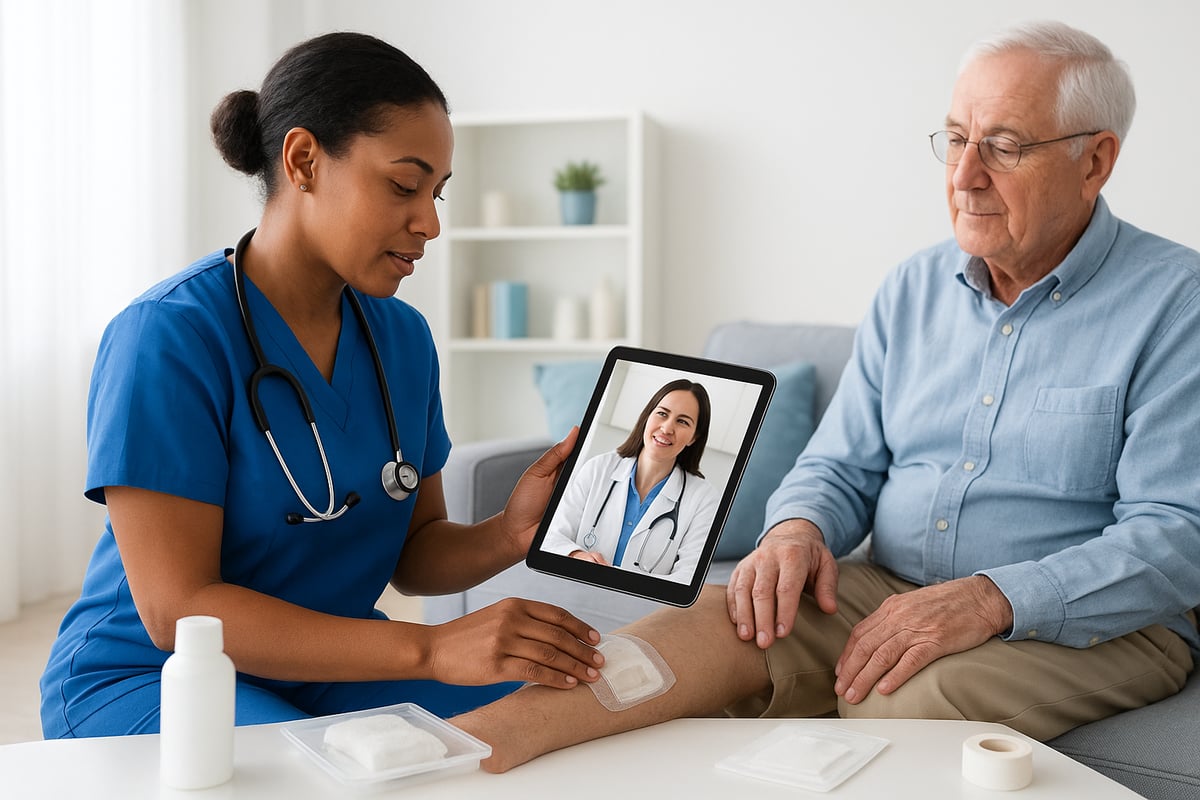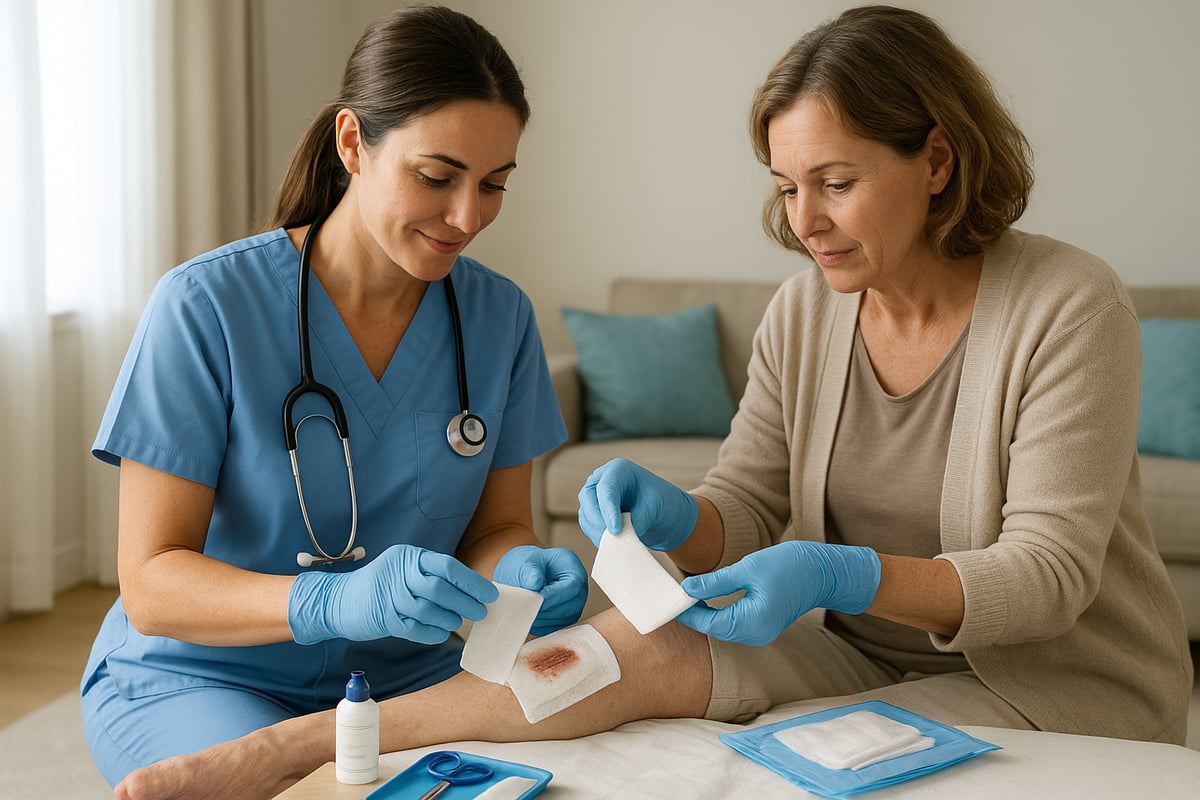Did you know that over 6.5 million Americans are affected by chronic wounds each year? As we look ahead to 2025, the need for effective home health care wound care is more critical than ever. This guide brings you expert insights and proven strategies to help manage wounds at home with confidence.
Inside, you will discover the latest trends in wound care, step-by-step approaches for home management, expert tips, technology updates, and valuable resources for patients and caregivers. Whether you are seeking faster healing, greater independence, or simply want to stay informed, this comprehensive guide is your essential companion for optimal home health care wound care.
Understanding Home Health Care Wound Care in 2025
Home health care wound care is rapidly evolving as more patients require expert support in the comfort of their own homes. In 2025, this approach is not only more accessible but also central to managing chronic wounds, thanks to new technology and coordinated care teams. According to recent Wound Care Industry Trends 2025, demand for home-based wound care is steadily rising as over 6.5 million Americans are affected by chronic wounds. Understanding the fundamentals of home health care wound care can empower both patients and families to achieve better healing outcomes.

What Is Home Health Wound Care?
Home health care wound care refers to the clinical management of wounds by healthcare professionals in a patient's own home. This model has gained ground as more individuals require ongoing support for chronic or complex wounds outside hospital settings. Care is typically delivered by skilled nurses, therapists, aides, and multidisciplinary teams under physician oversight. Eligibility often includes patients who have difficulty leaving home or need specialized wound care after surgery or injury. With 6.5 million Americans dealing with chronic wounds, the shift toward home health care wound care reflects both necessity and innovation. Current trends show a growing reliance on in-home services, making expert care more personal and accessible than ever before.
Types of Wounds Treated at Home
Home health care wound care covers a wide range of wound types, each requiring tailored strategies. Common wounds managed at home include:
- Surgical wounds
- Pressure ulcers
- Diabetic and neuropathic ulcers
- Venous stasis and arterial ulcers
- Burns and traumatic injuries
- Non-healing wounds
Elderly individuals and those with chronic conditions, such as diabetes or limited mobility, are most at risk. For example, a person with diabetes may develop a foot ulcer, while an immobile patient might face pressure injuries. Home health care wound care teams adapt their methods to support healing and prevent complications for each unique case.
The Home Health Care Team Approach
A successful home health care wound care plan relies on a coordinated team of professionals. Registered nurses, physical and occupational therapists, dietitians, social workers, and home health aides work together to provide holistic support. This approach addresses not only the wound itself but also factors such as nutrition, mobility, and coexisting medical conditions. In many homes, family caregivers partner closely with clinicians, learning to assist with dressing changes or mobility exercises. This team model ensures that every aspect of the patient's well-being is considered, leading to more comprehensive, effective care.
Goals and Benefits of Home-Based Wound Care
The primary goals of home health care wound care include faster healing, reduced risk of infection, fewer hospital readmissions, and greater comfort for patients. Additional benefits are:
- Empowering patients to participate in their own care
- Improving quality of life through personalized attention
- Providing ongoing education for patients and caregivers
Education is central, as it equips families with the skills and confidence needed to manage wounds safely at home. Ultimately, home health care wound care delivers expert support in familiar surroundings, helping patients regain independence and peace of mind.
Step-by-Step Guide to Wound Care at Home
Managing home health care wound care in 2025 requires a clear, methodical approach. By following expert-recommended steps, patients and caregivers can improve healing outcomes and reduce complications. Here, we break down each stage to help you deliver safe, effective care at home.

Step 1: Initial Assessment and Planning
The first step in home health care wound care is a comprehensive assessment. Evaluate the wound’s size, depth, type, and level of tissue damage. Document any signs of infection, such as redness, swelling, or unusual drainage.
Review the patient’s overall health. Consider chronic conditions like diabetes or vascular disease, which affect healing. A physician should oversee this process, ensuring the care plan is tailored to the individual.
For example, after surgery, a nurse may assess a patient’s incision for separation or infection. This evaluation guides dressing selection and frequency of care. Consistent, well-documented assessments lay the foundation for effective home health care wound care.
Step 2: Preparing the Home Environment
Setting up a clean, organized space is vital for home health care wound care. Choose a well-lit area with a flat surface for supplies. Ensure all necessary items are within reach before starting the procedure.
Prioritize infection control by practicing thorough hand hygiene. Disinfect surfaces before and after wound care. Dispose of used materials safely to reduce cross-contamination risk.
Adapt the environment to the patient’s mobility needs. Use chairs, stools, or grab bars for support. Remove tripping hazards and arrange supplies logically. This preparation helps maintain safety and minimizes stress during home health care wound care.
Step 3: Performing Wound Care Procedures
Proper wound care techniques are the core of home health care wound care. Begin by cleaning the wound with saline or an approved solution. Gently pat dry, then apply the prescribed dressing. Change dressings as directed, using sterile gloves and tools to prevent infection.
For advanced cases, clinicians may use negative pressure wound therapy, compression wraps, or gentle debridement. Monitor for increased pain, odor, or pus, which may signal infection.
Caregivers managing diabetic ulcers should watch for changes in skin color or sensation. For detailed, step-by-step protocols, refer to the Wound Care General Principles Guide, which offers foundational support for safe, effective practices at home.
Step 4: Supporting Healing through Nutrition and Lifestyle
Nutrition plays a crucial role in home health care wound care. Encourage a diet rich in protein, vitamin C, and zinc to promote tissue repair. Hydration is equally important for cellular function.
Address underlying health issues. For patients with diabetes, monitor blood sugar closely. Encourage smoking cessation and gentle mobility exercises to boost circulation.
For instance, a patient with slow-healing wounds may need dietary changes and guidance from a dietitian. These lifestyle adjustments are key for optimal home health care wound care results.
Step 5: Monitoring Progress and Preventing Complications
Regular monitoring is essential in home health care wound care. Measure the wound’s dimensions and photograph it at each dressing change to track healing.
Leverage technology—use apps or telehealth to consult with clinicians and share updates. Early detection of problems, such as delayed healing or new wounds, enables prompt intervention.
Recognize warning signs: increased redness, swelling, or systemic symptoms like fever. Timely action reduces the risk of complications in home health care wound care.
Step 6: Educating and Empowering Patients & Caregivers
Empowering patients and caregivers is the final step in home health care wound care. Teach wound care techniques through demonstration and easy-to-follow written instructions.
Provide checklists for daily care routines and a list of emergency contacts. Encourage patients to participate actively in their healing process by reporting changes or concerns immediately.
Ongoing education fosters confidence and independence, ensuring that home health care wound care remains safe and effective for everyone involved.
Latest Innovations and Technologies in Home Wound Care
The landscape of home health care wound care is rapidly evolving in 2025. New technologies and digital solutions are transforming how patients and caregivers manage wounds at home. These advancements are improving healing outcomes, increasing patient independence, and optimizing care efficiency.

Digital Tools and Telehealth
Digital tools are revolutionizing home health care wound care by enabling remote monitoring and specialist consultations. Telemedicine platforms allow clinicians to assess wounds through secure video calls, reducing the need for patient travel and providing timely expert input.
Patients and caregivers can use smartphone apps to photograph wounds, track healing progress, and communicate updates to the care team. For example, digital photography enables precise wound size measurements and documentation, ensuring that subtle changes are not missed. According to the Future of Wound Care: 6 Trends for 2025, telehealth and digital tools are among the top innovations shaping wound management this year.
By integrating digital tools, home health care wound care becomes more accessible and responsive, supporting better healing and patient satisfaction.
Advanced Wound Care Products and Therapies
Modern wound care relies on advanced products that address specific needs in home health care wound care. Clinicians now select from a wide range of dressings, including antimicrobial, moisture-retentive, foam, and hydrocolloid options.
Negative pressure wound therapy devices are more compact and user-friendly, making them suitable for home use. Compression wraps and devices are also available for managing venous ulcers. Evidence-based product selection ensures that each patient receives the most appropriate therapy for their wound type.
These innovations help reduce infection risk, speed up healing, and improve comfort for patients receiving home health care wound care.
Analytics and Early Intervention Algorithms
Data analytics are playing a critical role in home health care wound care. Clinicians utilize dashboards to monitor wound healing trends, identify at-risk patients, and trigger early interventions when progress stalls.
Algorithms analyze wound size, depth, and other parameters, alerting the care team to potential complications before they become serious. This proactive approach leads to fewer hospitalizations and better healing rates.
By leveraging analytics, home health care wound care teams ensure that patients receive timely adjustments to their treatment plans, supporting optimal outcomes.
Personalized and Holistic Care Plans
Personalization is at the heart of modern home health care wound care. Care plans are tailored to each patient's unique needs, considering comorbidities, mobility, nutritional status, and social support.
Multidisciplinary teams collaborate to integrate nutrition, mental health support, and lifestyle interventions into the wound care plan. For example, a patient with diabetes and limited mobility may receive coordinated support from nursing, therapy, and dietary specialists.
This holistic approach empowers patients and families, promoting independence and maximizing the benefits of home health care wound care.
Training and Continuous Education for Care Teams
Continuous education is essential for maintaining high standards in home health care wound care. Clinicians participate in training programs to stay current with new products, best practices, and emerging trends.
Certification and credentialing in wound care specialization are increasingly important, ensuring that home care teams are equipped to handle complex wounds. Family caregivers also benefit from education, receiving guidance and resources to confidently support wound care at home.
Ongoing training guarantees that home health care wound care remains safe, effective, and evidence-based for every patient.
Expert Tips for Optimal Wound Healing at Home
Optimizing outcomes in home health care wound care requires a blend of clinical expertise and practical daily routines. Below, discover proven strategies and actionable tips that empower patients and caregivers to promote healing, comfort, and independence at home.

Preventing Infection and Complications
Infection prevention is the cornerstone of successful home health care wound care. Ensuring a sterile environment and following strict protocols reduces the risk of complications.
- Wash hands thoroughly before and after any wound contact.
- Use gloves, sterile dressings, and disinfect all surfaces.
- Dispose of used materials in designated containers.
Recognizing early signs of infection—such as increased redness, swelling, warmth, or unusual drainage—is vital. Patients and caregivers should review resources like Infection Control for Home Care to stay informed on best practices. By being proactive, families can detect problems early and seek medical advice, supporting the overall effectiveness of home health care wound care.
Enhancing Comfort and Pain Management
Effective pain management is essential for patient comfort and healing. In home health care wound care, minimizing discomfort during dressing changes and daily activities improves quality of life.
- Choose dressings that do not stick to the wound bed.
- Administer prescribed pain medication before procedures.
- Adjust patient positioning to reduce pressure on wounds.
Utilizing gentle techniques during care routines, such as moistening dressings before removal, can help. For pressure ulcer patients, cushioning and careful movement are especially important. Open communication about pain levels enables tailored interventions, reinforcing the patient-centered approach of home health care wound care.
Promoting Mobility and Preventing Pressure Injuries
Maintaining mobility is critical for wound healing and preventing additional injuries. In home health care wound care, caregivers play a direct role in supporting movement and reducing risks.
- Reposition immobile patients at least every two hours.
- Use specialized mattresses, cushions, and offloading devices.
- Encourage gentle exercises as tolerated.
Early intervention can prevent pressure ulcers, especially in those with limited mobility. For more information, consider reviewing reputable educational tools on pressure ulcer prevention. Regular monitoring and collaboration with therapists further enhance the safety and effectiveness of home health care wound care.
Nutrition and Hydration Strategies
Nutrition is a powerful driver of wound healing. In home health care wound care, a balanced diet and proper hydration support tissue repair and immunity.
Essential nutrients include:
| Nutrient | Role in Healing | Food Sources |
|---|---|---|
| Protein | Cell growth, repair | Eggs, poultry, beans |
| Vitamin C | Collagen synthesis | Citrus, peppers |
| Zinc | Immune function | Meat, nuts, seeds |
Patients should drink adequate fluids and avoid processed foods. For those with diabetes or slow-healing wounds, working with a dietitian ensures that nutritional needs align with medical conditions. This holistic focus is a hallmark of home health care wound care.
Communication and Collaboration with Healthcare Providers
Clear communication is key to optimal outcomes in home health care wound care. Patients and caregivers must keep the care team informed of changes, challenges, and progress.
- Share wound measurements, photos, and symptom updates.
- Use telehealth for routine check-ins and urgent questions.
- Maintain a care journal to track daily routines and concerns.
Effective collaboration ensures care plans remain current and responsive. Promptly reporting warning signs, such as delayed healing or new symptoms, enables timely interventions, strengthening the partnership essential for home health care wound care.
Empowering Patients and Caregivers
Education and confidence-building are central to successful home health care wound care. Patients and families who understand procedures are more likely to adhere to care plans and notice early warning signs.
- Provide written guides, visual aids, and checklists.
- Offer hands-on training during professional visits.
- Supply emergency contacts for after-hours support.
Encouraging proactive participation transforms patients and caregivers into active partners. This empowerment enhances safety, promotes healing, and fosters independence—key outcomes of high-quality home health care wound care.
Who Needs Home Health Wound Care? Identifying Candidates and Eligibility
Deciding who benefits from home health care wound care is crucial for optimal outcomes. Not every wound needs in-home attention, but certain groups are at higher risk and should be evaluated for this specialized support. Understanding eligibility and recognizing when to seek help can make the difference in healing, comfort, and independence.
High-Risk Populations and Common Scenarios
Certain individuals face a greater need for home health care wound care due to their health status or living conditions. High-risk groups include:
- Older adults, especially those with mobility challenges.
- People living with diabetes, prone to foot ulcers and slow-healing wounds.
- Patients recovering from surgery or recent hospitalization.
- Individuals with vascular diseases, such as venous or arterial ulcers.
- Those confined to beds or wheelchairs, at risk for pressure injuries.
For example, chronic wounds impact around 6.5 million Americans, with diabetic foot ulcers and pressure injuries among the most common. Family caregivers often play a vital role in daily wound management. For detailed prevention tips, see Preventing Pressure Ulcers at Home.
Eligibility Criteria for Home Health Wound Care
Eligibility for home health care wound care depends on several factors, including insurance requirements and medical assessments. Key criteria typically include:
| Payer | Requirement | Notes |
|---|---|---|
| Medicare | Homebound, physician order | Must need skilled nursing care |
| Medicaid | Varies by state | Often mirrors Medicare guidelines |
| Private Ins. | Policy-specific | Check coverage and pre-approvals |
A physician must confirm that the patient is homebound and requires skilled wound care. The home environment must also be safe for care delivery. Meeting these criteria allows patients to receive comprehensive wound management at home.
Recognizing When to Seek Home-Based Wound Care
Certain warning signs signal the need for home health care wound care. These include wounds that do not improve within two weeks, or fail to heal after six weeks. Other indicators are:
- Development of new Stage III or IV pressure ulcers.
- Complex wounds requiring advanced therapies.
- Underlying conditions like diabetes or poor circulation.
Early intervention is vital to prevent complications and reduce hospital admissions. If you notice persistent redness, increased drainage, or spreading infection, contact your healthcare provider promptly.
Family and Caregiver Involvement
Family members often become essential partners in home health care wound care. Their responsibilities may include monitoring the wound, assisting with dressing changes, and reporting changes to clinicians.
Education and training are vital for caregiver confidence and patient safety. For instance, a caregiver might learn to change a loved one’s surgical dressing after discharge, following instructions from the wound care team. Ongoing support helps families manage care effectively and recognize when professional help is needed.
How to Find and Choose a Home Health Wound Care Specialist
Choosing the right specialist for home health care wound care is vital for optimal healing and peace of mind. Navigating the selection process can feel overwhelming, but a step-by-step approach ensures you make informed decisions. Here is how to identify, evaluate, and select the best provider for your unique needs.
Consulting Your Physician and Getting a Referral
Begin your journey to effective home health care wound care by discussing your needs with your primary care physician or specialist. Physicians play a central role in identifying when home-based wound care is appropriate, especially for chronic or complex wounds.
Your doctor will assess your medical history, wound type, and overall health status. Based on this assessment, they can recommend home health care wound care services that fit your condition. Physicians are also responsible for providing an official order or referral, which is often required by insurance providers to initiate care.
Patients have the right to choose their preferred agency or specialist. Ask your physician for a list of reputable home health care wound care providers in your community, and do not hesitate to inquire about their experience with specific agencies.
Evaluating Quality and Credentials of Providers
Once you have referrals, carefully evaluate each home health care wound care provider’s credentials and quality measures. Look for agencies and clinicians with recognized certifications in wound care, such as WOCN (Wound, Ostomy, and Continence Nursing) or CWCN (Certified Wound Care Nurse).
Check for accreditations from national organizations and review public quality scores, which may be available through Medicare or state health departments. Patient testimonials and case studies can offer real-world insights into provider performance.
Given the rising demand and evolving practices in the field, many agencies are embracing technology and advanced therapies. Learn more about how home health providers are stepping up to meet rising demand for wound care services, and ensure your chosen provider keeps pace with industry standards.
Questions to Ask Potential Providers
Before committing to a home health care wound care team, interview potential providers to ensure their approach matches your needs. Key questions include:
- What is the composition of your wound care team?
- How much experience do you have with my specific wound type?
- What advanced therapies or technologies do you use?
- How do you track and share wound progress?
- What is your protocol for emergencies or urgent concerns?
Use these questions to gauge the provider’s communication style, transparency, and ability to personalize care. Providers who are open, knowledgeable, and patient-focused are more likely to deliver high-quality home health care wound care.
Resources for Patients and Caregivers
Accessing the right resources can make home health care wound care more manageable for both patients and caregivers. Look for national organizations, local support groups, and educational materials that offer up-to-date guidance.
Many agencies provide printed guides and online platforms for telehealth support, allowing for virtual check-ins and timely advice. For those managing diabetic wounds, consider exploring Diabetic Foot Ulcers Prevention for additional tips and resources.
Finally, seek assistance with insurance questions, equipment needs, and financial support. Empowering yourself with information and a strong support network is key to successful home health care wound care.






